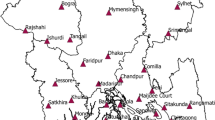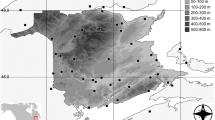Abstract
Recently in agricultural and industrial sectors, researchers have started to classify the climate of a region using empirical methods and clustering. This study aims to compare four empirical approaches to climate classification (Thornthwaite and Mather, De Martonne, the Extended De Martonne, and the IRIMO (I.R. of Iran Meteorological Organization)) with Ward’s hierarchical agglomerative clustering applied to the climate of Iran. The dataset used in this study comprises maximum and minimum temperatures and precipitation data of 356 weather stations extracted from IRIMO’s databases. Thirty-five synoptic weather stations are selected among 356 stations. These stations are selected regarding the best uniform distribution, elevation, windward and leeward sides of the mountain ranges, and availability of a continuous 50-year data (1966–2015). Compared with the other three empirical reference methods of climate classification, the Thornthwaite and Mather method emphasizes the role of water bodies and air masses in determining the climate type of a region. Highlighting these two factors is identified as the main advantage of this method over the other three. This advantage is the most noticeable for the highlands/mountainous regions, in the vicinity of the Zagros Mountains, and in the western regions of Iran. As a case in point, while in the De Martonne and the Extended De Martonne methods, the Zagros storm cell is climatically classified similar to patchy areas in Caspian Sea coastal zone, this cell is correctly identified as a separate zone in the Thornthwaite and Mather method. The results also reveal that the clusters obtained from Ward’s algorithm are comparable to those of empirical climate classifications, particularly Thornthwaite and Mather method.







Similar content being viewed by others
Availability of data and material
The data that support the findings of this study are available on request from the corresponding author.
Change history
09 November 2021
A Correction to this paper has been published: https://doi.org/10.1007/s00704-021-03847-y
References
Abounoori AA (2010) Analysis of agricultural drought phenomenon in Ramsar city by Thornthwaite method. J Geogr Space 28:1–39
Adl AH (1960) Climatic divisions and vegetation of Iran. University of Tehran Publications, Tehran
Aguilar E, Auer I, Brunet M, Peterson TC, Wieringa J (2003) Guidance on metadata and homogenization. WMO Td 1186:1–53
Alavipanah SK, Shamsipour AA, Amiri R (2007) a study of the relationship among temperatures of surface features and its application in remote sensing study of Lut desert. J Desert 12:85–97. https://doi.org/10.22059/jdesert.2008.31070
Alexanderson H, Moberg A (1997) Homogenization of Swedish temperature data Part 1: homogeneity test for linear trends. Int J Climatol 17:25–34. https://doi.org/10.1002/(SICI)1097-0088(199701)17:1<25::AID-JOC103>3.0.CO;2-J
Aparecido LEDO, Rolim GDS, Richetti J, Souza PSD, Johann JA (2016) Köppen, Thornthwaite and Camargo climate classifications for climatic zoning in the State of Paraná. Cienc Agrotec 40:405–417. https://doi.org/10.1590/1413-70542016404003916
Baltas E (2007) spatial distribution of climatic indices in northern Greece. Meteorol Appl 14:69–78. https://doi.org/10.1002/met.7
BazrafshanDaryasari M, MeftahHalghi M, Gorbani Kh, Ghahraman N (2016) Comparative study of climate regions of Golestan province under different climate change scenarios. J Water Soil Conserv 22:187–202
Buishand TA (1982) some methods for testing the homogeneity of rainfall records. J Hydrol 58:11–27. https://doi.org/10.1016/0022-1694(82)90066-X
De Martonne E (1941) Traite de Geographie Physique: 3 tomes, Paris. Flocas AA. 1994. Courses of Meteorology and Climatology. Ziti Publications: Thessaloniki
Dinpajouh Y, Fakheri A, Moghadam M, Mirnia M, Jahanbakhah S (2003) Zoning climate of Iran using multivariate analysis for using agricultural studies. J Agri Sci and Sustain Prod 13:71–90
Feddema JJ (2005) A revised Thornthwaite-type global climate classification. Phys Geogr 26:442–466. https://doi.org/10.2747/0272-3646.26.6.442
Ganji MH (1954) Iran's climatic divisions. Faculty of Literature, University of Tehran, Tehran, Iran 9:1–47
Ghaemi H, Zarrin A, KhoshAkhlagh F (2012) Climatology of Arid Regions. Samt Publications, Tehran, Iran
Ghaffari A, Ghasemi VR, De Pauw E (2015) Agro-Climatology Zoning of Iran by UNESCO approach approach. J Dryland Agric 4:63–95
Ghorbani Kh, AghaShariatmadary Z (2014) The effect of local gradients on increasing of climate data interpolation accuracy by geographically weighted regression (case study: Air temperature and relative humidity). J Watershed Manag Res 10:132–143
Ghorbani Kh, BazrafshanDaryasari M, MeftahHalaghi M, Ghahreman N (2016) The effect of climate change on DeMarton climate classification in Golestan province. J Soil Water Res 47:319–332
GolkarHamzee Yazd HR, Rezayinezhad M, Tavousi M (2016) Climate zoing of south Khorasan province with GIS software. J Water Soil Resour Conserv 6:47–60
Heidari H, Alijani B (2000) Climatic Classification of Iran using multivariate statistical techniques. J Geogr Res Q 37:57–74
IRIMO (2016) Applied meteorological development plan report, No.1, Agricultural Meteorology
Jain AK, Murty MN, Flynn PJ (1999) Data Clustering: A Review. ACM Comput Surv 31:264–323
Javadi C (1966) Distribution climatiques en Iran. Monographie Meteorol Nat, Paris
Kent P, Jensen RK, Kongsted A (2014) A comparison of three clustering methods for finding subgroups in MRI, SMS or clinical data: SPSS twostep cluster analysis, latent Gold and SNOB. BMC Med Res Methodol 14:113. https://doi.org/10.1186/1471-2288-14-113
Khalili A (1973) The scientific understanding of climate and weather. IRIMO publication, Tehran
Köppen W (1900) Versucheiner Klassifikation der Klimate, vorzugsweise nach ihren Beziehungen zur Pflanzenwelt. Geogr Z 6:657–679
Köppen W (1931) Grundriss der Klimakunde. Walter de Gruyter and Co, Berlin
Leech G (2014) Classification of Arid & Semi-Arid Areas: A Case Study in Western Australia. J ANU Undergrad Res 5:79–100
Masoudian SA (2011) Climate of Iran. University of Isfahan Press, Isfahan, Iran
Masoudian SA (2003) Climatic regions of Iran, Geography and Development Iranian J. 2:171–184. https://doi.org/10.22111/gdij.2003.3821
Mavrakis A, Papavasileiou H (2013) NDVI and E. de Martonne indices in an environmentally stressed area (Thriasio Plain–Greece). Proc Technol 8:477–481. https://doi.org/10.1016/j.protcy.2013.11.062
Mirmousavi SH, Kiani H (2017) An investigation on Köppen’s Climate Classification in 1975 in Comparison with the Output of MIROC in the years 2030, 2050, 2080, and 2100 under Scenario A1B and A2. J Geogr Environ Hazards 7:59–72
Moradian M (2016) Comparison of Geopotential height anomalies of atmospheric lower levels in drought and wet years of Iran, (Master thesis, University of Tehran)
Müller MDS, Dourado-Neto D, Timm LC, Reichardt K, Sartori FF, Felisberto G (2018) Climate analysis for agricultural improvement of the Economic Community of West African States according to Köppen and Thornthwaite. Afr J Agric Res 13:1198–1212. https://doi.org/10.5897/AJAR2018.13064
Netzel P, Stepinski T (2016) on using a clustering approach for global climate classification. J Climate 29:3387–3401. https://doi.org/10.1175/JCLI-D-15-0640.1
Norusis MJ (2010) Chapter 16: Cluster analysis. PASW Statistics 18 Statistical Procedures Companion (pp 361–391). Upper Saddle River: Prentice Hall
Nouri Mohammadiyeh M, Mohammadi M, Sohrabi T (2009) Calibration of modified Thornthwaite method in calculation of potential evapotranspiration (Case study: Safidrood Basin), International Conference on Water Resources, Shahrood University of Technology, 1–8
Pettit AN (1979) A non-parametric approach to the change-point detection. J Appl Stat 28:126–135. https://doi.org/10.2307/2346729
Piri I, Khanamani A, Shojaei S, Fathizad H (2017) Determination of the best geostatistical method for climatic zoning in Iran. Appl Ecol Env Res 15:93–103. https://doi.org/10.15666/aeer/1501_093103
Poormohammadi S, Malekinezhad H (2013) Classification of homogeneous climate regions under the impact of climate change and greenhouse gas emissions scenarios using L-Moments technique in Iran. J Watershed Manag Res 8:58–76
Rahimi J, Ebrahimpour M, Khalili A (2013) spatial changes of extended De Martonne climatic zones affected by climate change in Iran. THEOR APPL CLIMATOL 112:409–418. https://doi.org/10.1007/s00704-012-0741-8
Raziei T (2017) Köppen-Geiger climate classification of Iran and investigation of its changes during 20th century. J Earth Space Phys 43:419–439
Rubel F, Brugger K, Haslinger K, Auer I (2017) the climate of the European Alps: Shift of very high resolution Köppen-Geiger climate zones 1800–2100. Meteorol Z 26(2):115–125. https://doi.org/10.1127/metz/2016/0816
Shi J, Yang L (2020) A Climate Classification of China through k-Nearest-Neighbor and Sparse Subspace Representation. J Climate 33:243–262. https://doi.org/10.1175/JCLI-D-18-0718.1
Siabi N, Sanaeinejad H (2013) An investigation into using of combined geostatistical methods to increase precision in climatology classification and climate parameters zoing in great Khorasan. J Climatol Res 15:81–92
Strahler AN, Strahler AH (1978) Modern physical geography. Wiley, New York
Thornthwaite CW (1948) An approach toward a rational classification of climate. Geogr Rev 38:55–94. https://doi.org/10.2307/210739
Thornthwaite CW, Mather JR (1955). The water balance. Publications in climatology
Umar R, Yusuf M (2019) Determination of the Growing Season for Dry Land Agriculture Based on Thornthwaite Method in Bulukumba Regency. South Sulawesi Province. J Phys Conf Ser. https://doi.org/10.1088/1742-6596/1244/1/012032
Vieira MT, Meireles AC, de Oliveira CW, do Nascimento MT, (2017) Koppen-Geiger and Thornthwaite climatic classification for the metropolitan region of the Cariri, Ceará. J Revista Geama 3:136–143
Wijngaard JB, Klein Tank AMG, Können GP (2003) Homogeneity of 20th century European daily temperature and precipitation series. Int J Climatol 23:679–692. https://doi.org/10.1002/joc.906
Willmott CJ (1982) Some comments on the evaluation of model performance. Bull Amer Meteor 63:1309–1313. https://doi.org/10.1175/1520-0477(1982)063<1309:SCOTEO>2.0.CO;2
Worsley KJ (1979) on the likelihood ratio test for a shift in location of normal populations. J Am Stat Assoc 47:365–367. https://doi.org/10.1080/01621459.1979.10482519
Zarei AR (2014) Evaluation of changes in different climates of Iran, using De Martonne index and Mann-Kendall trend test. Nat Hazaed Earth Sys 2:2245–2261. https://doi.org/10.5194/nhessd-2-2245-2014
Zarei R, Sarajian M, Bazgeer S (2013) Monitoring Meteorological Drought in Iran Using Remote Sensing and Drought Indices. J Desert 18:89–97. https://doi.org/10.22059/JDESERT.2013.36279
Acknowledgements
The authors gratefully acknowledge the I.R. of Iran Meteorological Organization (IRIMO) for providing meteorological data from synoptic stations.
Funding
This research was supported by Iran National Science Foundation (INSF) by grant No. 2016/95838893.
Author information
Authors and Affiliations
Contributions
Material preparation and data collection were performed by Faezeh Abbasi and Saeed Bazgeer. The statistical analysis was done by Saeed Bazgeer, Ebrahim Asadi Oskoue, and Masoud Haghighat. The first draft of the manuscript was prepared by Faezeh Abbasi, Saeed Bazgeer, and Parviz Rezazadeh Kalehbasti. The interpretation of the maps was done by Saeed Bazgeer, Parviz Rezazadeh Kalehbasti, Ebrahim Asadi Oskoue, and Masoud Haghighat. The final version of manuscript was written by Saeed Bazgeer, Parviz Rezazadeh Kalehbasti, and Pouya Rezazadeh Kalehbasti.
Corresponding author
Ethics declarations
Ethics approval
The authors have agreed for authorship, read and approved the manuscript, and given consent for submission and subsequent publication of the manuscript.
Consent to participate
All authors consent to participate of the present study.
Consent for publication
All authors read the manuscript and agree for the publication.
Conflicts of interest
The authors declare that there is no conflict of interest.
Additional information
Publisher's note
Springer Nature remains neutral with regard to jurisdictional claims in published maps and institutional affiliations.
The original online version of this article was revised: The author name Pouya Rezazadeh Kalehbasti was incorrectly written as Pouya Rezazadeh Kalebasti.
Rights and permissions
About this article
Cite this article
Abbasi, F., Bazgeer, S., Kalehbasti, P.R. et al. New climatic zones in Iran: a comparative study of different empirical methods and clustering technique. Theor Appl Climatol 147, 47–61 (2022). https://doi.org/10.1007/s00704-021-03785-9
Received:
Accepted:
Published:
Issue Date:
DOI: https://doi.org/10.1007/s00704-021-03785-9




